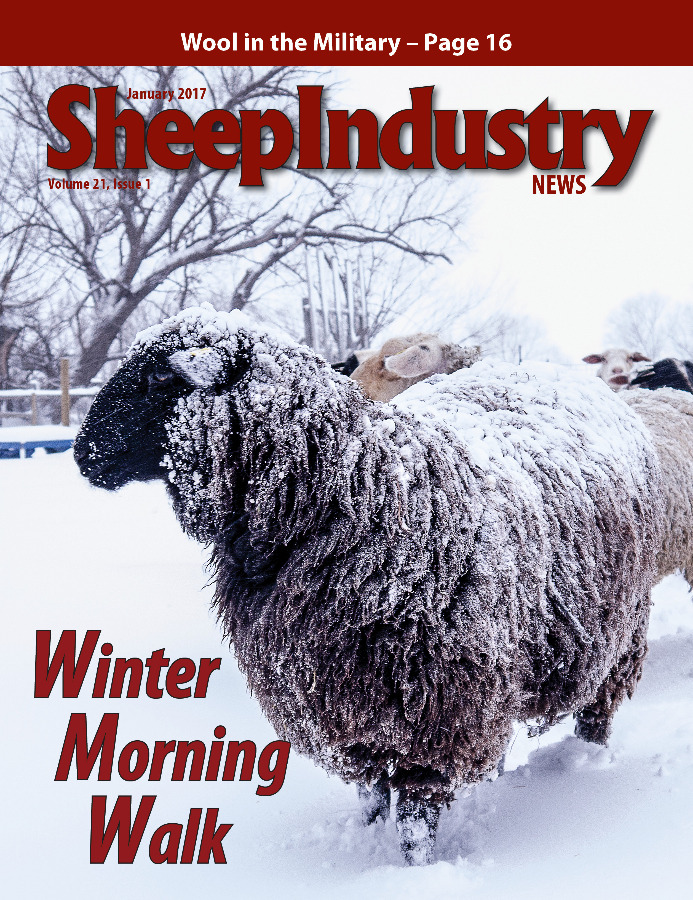Combating Intestinal Parasites
TERRI QUECK-MATZIE
Special to the Sheep Industry News
Intestinal parasites don’t just plague sheep and goats in the warm, humid southern states.
“It’s a problem anywhere sheep are grass fed,” says Katherine Petersson, Associate Professor of Animal and Veterinary Science at the University of Rhode Island. “Here in the northeast, parasites aren’t as much a problem as in the south, but we’re still losing animals and losing productivity.”
Petersson, in collaboration with Virginia Tech Parasitologist Anne Zajac, has been educating producers about parasite risks and methods of control.
“Our focus has been on promoting best management practices like pasture rotation, fecal egg count monitoring and using the Faffa Malan Chart to detect anemia resulting from infection by Haemonchus contortus, more commonly known as the barber pole or wire worm,” says Petersson,
Producers in the region can access workshops and online training, but Petersson says she would like to take the effort further. With a $235,000 grant through the USDA Sustainable Agriculture Research and Education program, she has expanded her focus to educate producers on parasite susceptibility as a factor in breeding decisions.
“What we’ve found as we interact with producers is hardly anyone is taking parasite resistance into consideration when choosing breeding stock,” says Petersson. “With this grant, we want to highlight selective breeding as a way to control internal parasites.”
To back up the university’s research and outreach programs, Petersson has enlisted the National Sheep Improvement Program. Natural resistance to parasite infestation is a heritable trait, and NSIP provides an Estimated Breeding Value for fecal egg count.
“We want producers to understand the importance of breeding sheep that not only look good, but perform. And that means not losing productivity to parasites,” says Petersson. “With NSIP, they can make informed decisions.”
The Rhode Island program is an easy fit for NSIP. Program Director Rusty Burgett has already provided workshops in the region, with more to come.
“The EBVs offered by NSIP are focused around the economic drivers of sheep producers,” says Burgett. “Using them to decrease the parasite burden in a flock will certainly have an impact on productivity and profitability.”
FEC might not be the sole criteria for selecting breeding stock, but Petersson says it should be a consideration for anyone feeding sheep on grass. Her program provides a two-pronged approach. The grant includes $7,000 per year to cover the cost of processing fecal egg count samples at Virginia Tech. Producers can submit two samples per animal, paying only the cost of shipping, in an effort to encourage producers to profile their breeding stock for parasite susceptibility.
Phase two of the plan is to promote NSIP as a tool for selective breeding. “The infrastructure is there to process and present the data. We just need to educate producers in how to use it,” says Petersson.
She says there are many reasons for producers to understand all available parasite control strategies. Aside from increasing productivity and efficiency, there’s pressure to decrease the use of chemical pesticides in food production.
“Dewormers are very safe,” says Petersson, “but they are losing efficacy.”
For long-term results, breeding for parasite resistance makes sense. Breeding stock with a low fecal egg count EBV will produce progeny with less risk of infestation. Conversely, animals with a high fecal egg count EBV can be culled to eliminate the prospect of progeny with a high susceptibility.
However, Petersson says it is not as simple as looking at just one number.
“It’s also important to buy seedstock raised in similar environmental conditions,” she said. “Sheep that have not been on grass might have low fecal egg count numbers, but that number could be skewed by lack of exposure, or parasite-unfriendly environmental conditions. Producers need a clear picture of that animal’s potential performance on pasture.”
That’s where EBVs come in, as they estimate the genetic potential of an animal by accounting for the environmental differences.
Other production goals must be considered, as well. Loin eye and depth, maternal characteristics, growth potential – make the basis for any breeding decision. Petersson and Burgett want producers to add FEC to that list.
To make animals with good FEC EBVs more readily available, NSIP is sponsoring the first-ever Eastern NSIP Sheep Sale at the Wayne County Fairgrounds in Wooster, Ohio, in August 2017. Patterned after the popular Center of the Nation Sale held each July in Spencer, Iowa, the sale will not only feature breeding stock with NSIP EBVs, but a full agenda of educational programming. Petersson plans to be one of the presenters.
“The use of breeding stock with EBVs has increased dramatically in the midwest and mountain west regions. Now it’s time to provide Eastern producers access to the most profitable genetics,” says Burgett. “There are several flocks in the region enrolled in NSIP and we want to help them get those genetics into the commercial sector and start making a difference. The Eastern NSIP sale will be a great way to do that, and to get some producer discussions going at the educational sessions. It will be a fun sale because we’ll have several different breeds and different selection goals, so there will be genetics fine-tuned for everyone available.”
“We want to raise the seedstock bar,” says Petersson, “as well as awareness of the parasite problem and possible solutions. We don’t have the big flocks here like they do on the western range. We have a lot of smaller producers and a lot of small farms. But they’re still looking for sires. We hope by giving them the information they need and better access to the right animals, they can increase their productivity and profit.”
To find more information on the University of Rhode Island Northeast Small Ruminant Parasite Control program visit the program’s website at web.uri.edu/sheepngoat/. More information on NSIP can be found at NSIP.org.


